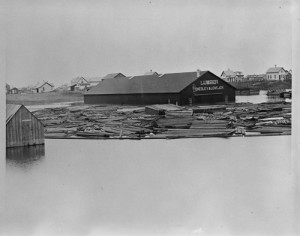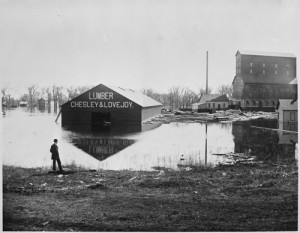
Looking northwest at Chesley & Lovejoy Lumberyard, east end of 2nd Ave. N. during Red River flood. Residential area in background above water. Lumber floating between buildings [North Dakota State University Archives, Digital ID: rs000968]
In the first decade of Fargo’s settlement, concerns for sanitation and waste management quickly rose to the forefront of city operations. As an infrastructure developed, the need for a sewage system for Fargo was clear and the city council investigated the system and its cost. On January 13, 1881, council members solicited city engineers for a sewage system that best met the needs of the flat city. On September 14, 1882, voters approved, 136 to 25, a $50,000 issue of 7-percent bonds for a system based on the existing structure in Chicago. Fargo’s city engineers adapted that to a more modern system with 36-inch brick trunks fed laterally by 12-inch pipes throughout the main center of the city as opposed to Moorhead’s flush tanks that initially sent waste directly to the river.
[1]Nevertheless, Fargo’s sewers continued to empty into the river and taint water supplies until 1892, when improvements began.
Proximity to the river greatly facilitated day-to-day business activities and steamboat landings and served nearby warehouses and granaries. Due to the overall unsanitary nature of the river water during the early developmental periods, that proximity could also cause problems. Therefore, the ongoing need for revising the existing systems of irrigation and sanitation remained at the at the forefront of concerns of the city council and local citizens alike.

Chesley & Lovejoy Lumberyard, at the east end of 2nd Ave. N., is shown during the Red River flood. The Union Elevator cam be seen in the background and lumber floats between between buildings. The man standing in foreground is looking east at the view. [North Dakota State University Archives, Digital ID: rs000967]
Although the Red River provided ease of access and transfer of goods and lumber coming and going from Fargo, it also created instances of immense loss and devastation during high water times. Flooding affected any and all structures and businesses along the banks including lumber yards and granaries originally founded close by for quick and efficient transactions.
-Stacy M. Reikowsky, Digital History 2012
[1] Englehardt, Gateway, 267.


